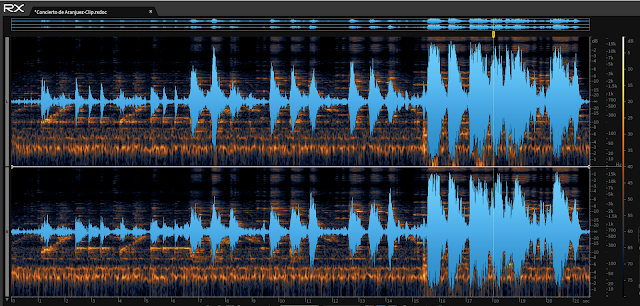The disk was simply labeled "Concierto de Aranjuez, Joaquin Rodrigo." It was an orchestral piece that featured a Spanish Guitar soloist. It was alternately melancholy and spirited. It deserved better treatment.
In retrospect, there are some perfectly wonderful recordings of this work floating around. EMI sells one with Placido Domingo conducting the Philharmonia Orchestra and you can also get Louis Fremaux, also conducting the Philharmonia Orchestra, from Sony. But no, none of that pre-baked stuff for this boy. This was probably something different and older and of historical importance.
I've chosen a segment that begins with a quiet stretch, which reveals the vinyl noise, and moves into a strident burst of enthusiasm that is too loud and thus distorted. Also, there is clearly some 50-cycle hum, especially in the right channel. That marks it as coming from Europe -- maybe England. Maybe this is the performance that ended up on EMI Classics - Simon Rattle conducting the City of Birmingham Symphony Orchestra with Julian Bream on guitar. Well, that's enough to start with. Let's have a go.
We'll start by having a listen and examining the spectrogram. I always check my Waveform Statistics first. It tells me:
- My True Peak Level is as much as +0.45 dB (this puppy is HOT), that
- I have upwards of 1300 Possibly Clipped Samples in each 21-second track and that
- There is a relatively-minor DC Offset of +0.030%.
- That bright orange line near the bottom is a 50-cycle hum that is especially-prominent in the right channel.
- From the dark lines toward the top of each channel, it looks like someone has already hit this recording with a crude low-Q comb filter. That's too bad. Once the sound is gone, there is not enough fairy dust in the world to make it there again. Note to self: When editing and filtering, always take the smallest, most precise bites possible.
Okay, I've had some fun. I:
- Used De-hum Manual/Learn on that 50-cycle thingie. Actually, it told me that the frequency was 51.66 Hz. I tightened my filter Q up to 1500 and took a very tight strip out of the signal. There was quite a lot of useless energy in that hum that would have robbed us of program loudness in my last standards-compliance step. BTW, I also checked the Filter DC Offset box and cleared up two issues in one pass.
- Used De-clip's Extreme Analog Clipping preset. Now, the Statistics window reports under a dozen clipped peaks. Good enough. I think I'll leave that alone.
- Used De-click in three passes (High, Mid, and Low) until the background noise was more like hiss than discrete clicks.
- I wanted to use the De-noise module, but there were no sections of silence to show it what was noise and what was not. Well, heck. So, noticing that most of the noise I wanted to kill was high-frequency hiss, I selected spectrum above the primary sound from quieter sections and used that to teach the De-noise algorithm. Not bad. Let's have another look and listen, before I make the recording conform to Broadcast Loudness standards.
Well, that's better. You can see:
- That hum line is gone.
- Excursions spontaneously dropped below 0 dB.
- Many "dusty" high frequency spectral areas went dark. We sent that noise to the other place.
- There's still some annoying mid-range hiss, but if I were working on the entire piece instead of a 21-second clip (with no silent moments), I could find better samples to show De-noise what was good and what was evil.
Oops, I mustn't get too presumptions or lightning may strike me dead. Catch you next time, your very humble servant, DavidS



No comments:
Post a Comment